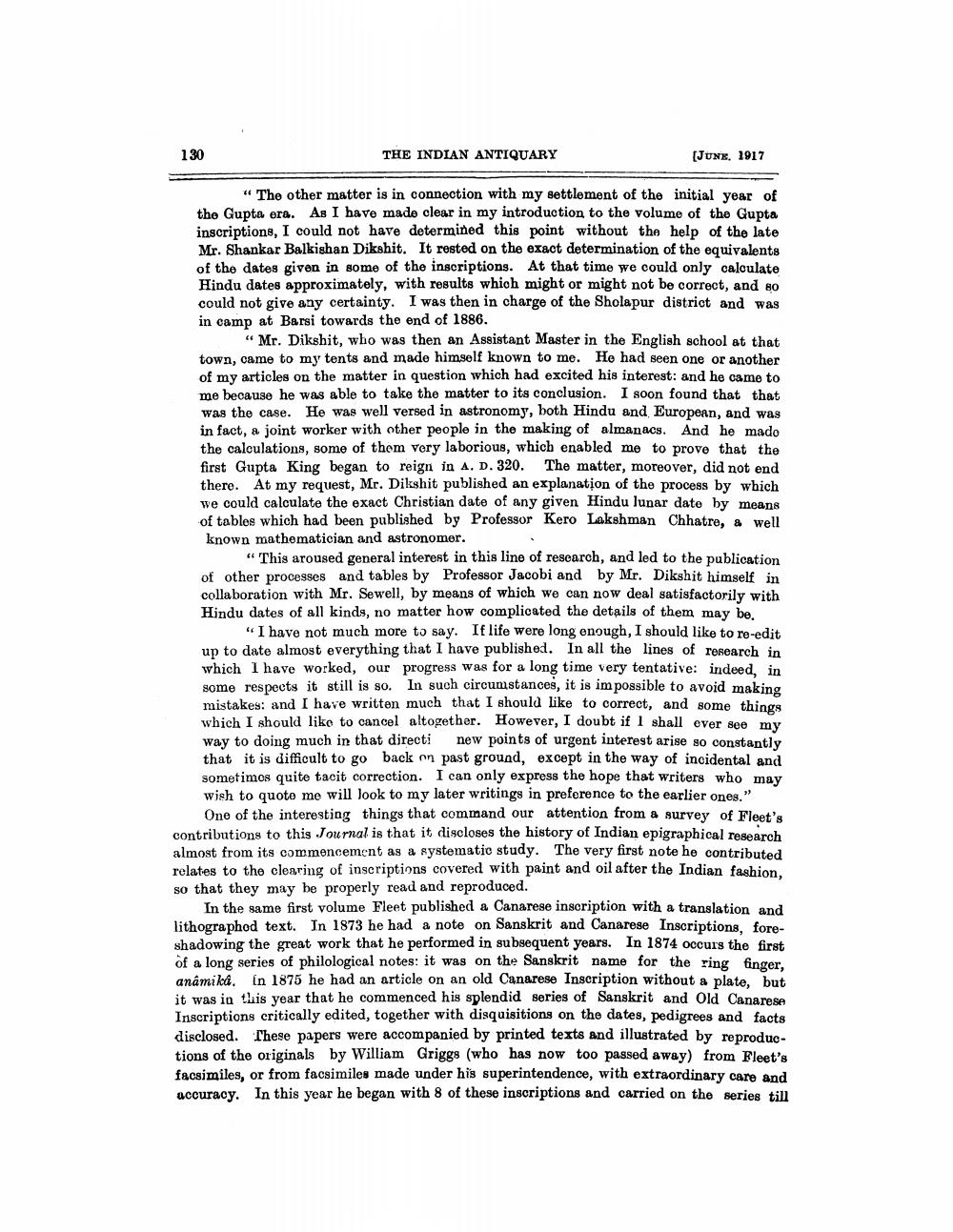________________
130
THE INDIAN ANTIQUARY
(JUNE, 1917
* The other matter is in connection with my settlement of the initial year of the Gupta era. As I have made clear in my introduction to the volume of the Gupta inscriptions, I could not have determined this point without the help of the late Mr. Shankar Balkishan Dikshit. It rested on the exact determination of the equivalents of the dates given in some of the inscriptions. At that time we could only calculate Hindu dates approximately, with results which might or might not be correct, and so could not give any certainty. I was then in charge of the Sholapur district and was in camp at Barsi towards the end of 1886.
« Mr. Dikshit, who was then an Assistant Master in the English school at that town. came to my tents and made himself known to me. Ho had seen one or another of my articles on the matter in question which had excited his interest: and he came to me because he was able to take the matter to its conclusion. I soon found that that was the case. He was well versed in astronomy, both Hindu and European, and was in fact, a joint worker with other people in the making of almanacs. And he mado the calculations, some of thom very laborious, which enabled me to prove that the first Gupta King began to reign in A. D. 320. The matter, moreover, did not end there. At my request, Mr. Dikshit published an explanation of the process by which we could calculate the exact Christian date of any given Hindu lunar date by means of tables which had been published by Professor Kero Lakshman Chhatre, & well known mathematician and astronomer.
"This aroused general interest in this line of research, and led to the publication of other processes and tables by Professor Jacobi and by Mr. Dikshit himself in collaboration with Mr. Sewell, by means of which we can now deal satisfactorily with Hindu dates of all kinds, no matter how complicated the details of them may be.
"I have not much more to say. If life were long enough, I should like to re-edit up to date almost everything that I have published. In all the lines of research in which I have worked, our progress was for a long time very tentative: indeed, in some respects it still is so. In such circumstances, it is impossible to avoid making mistakes: and I have written much that I should like to correct, and some things which I should like to cancel altogether. However, I doubt if I shall ever see my way to doing much in that directi new points of urgent interest arise so constantly that it is difficult to go back on past ground, except in the way of incidental and sometimos quito tacit correction. I can only express the hope that writers who may wish to quoto me will look to my later writings in preference to the earlier ones."
One of the interesting things that command our attention from & survey of Fleet's contributions to this Journal is that it discloses the history of Indian epigraphical research almost from its commencement as a systematic study. The very first note he contributed relates to the clearing of inscriptions covered with paint and oil after the Indian fashion. so that they may be properly read and reproduced.
In the same first volume Fleet published a Canarese inscription with a translation and lithographod text. In 1873 he had a note on Sanskrit and Canarese Inscriptions, foreshadowing the great work that he performed in subsequent years. In 1874 occurs the first of a long series of philological notes: it was on the Sanskrit name for the ring finger, anamika. În 1875 he had an article on an old Canarese Inscription without a plate, but it was in this year that he commenced his splendid series of Sanskrit and Old Canarese Inscriptions critically edited, together with disquisitions on the dates, pedigrees and facts disclosed. These papers were accompanied by printed texts and illustrated by reproductions of the originals by William Griggs (who has now too passed away) from Fleet's facsimiles, or from facsimiles made under his superintendence, with extraordinary care and accuracy. In this year he began with 8 of these inscriptions and carried on the series till




